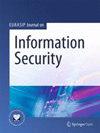Evaluation of stability of swipe gesture authentication across usage scenarios of mobile device
IF 2.5
Q2 COMPUTER SCIENCE, INFORMATION SYSTEMS
引用次数: 8
Abstract
User interaction with a mobile device predominantly consists of touch motions, otherwise known as swipe gestures, which are used as a behavioural biometric modality to verify the identity of a user. Literature reveals promising verification accuracy rates for swipe gesture authentication. Most of the existing studies have considered constrained environment in their experimental set-up. However, real-life usage of a mobile device consists of several unconstrained scenarios as well. Thus, our work aims to evaluate the stability of swipe gesture authentication across various usage scenarios of a mobile device. The evaluations were performed using state-of-the-art touch-based classification algorithms—support vector machine (SVM), k-nearest neighbour (kNN) and naive Bayes—to evaluate the robustness of swipe gestures across device usage scenarios. To simulate real-life behaviour, multiple usage scenarios covering stationary and dynamic modes are considered for the analysis. Additionally, we focused on analysing the stability of verification accuracy for time-separated swipes by performing intra-session (acquired on the same day) and inter-session (swipes acquired a week later) comparisons. Finally, we assessed the consistency of individual features for horizontal and vertical swipes using a statistical method. Performance evaluation results indicate impact of body movement and environment (indoor and outdoor) on the user verification accuracy. The results reveal that for a static user scenario, the average equal error rate is 1%, and it rises significantly for the scenarios involving any body movement—caused either by user or the environment. The performance evaluation for time-separated swipes showed better verification accuracy rate for swipes acquired on the same day compared to swipes separated by a week. Finally, assessment on feature consistency reveal a set of consistent features such as maximum slope, standard deviation and mean velocity of second half of stroke for both horizontal and vertical swipes. The performance evaluation of swipe-based authentication shows variation in verification accuracy across different device usage scenarios. The obtained results challenge the adoption of swipe-based authentication on mobile devices. We have suggested ways to further achieve stability through specific template selection strategies. Additionally, our evaluation has established that at least 6 swipes are needed in enrolment to achieve acceptable accuracy. Also, our results conclude that features such as maximum slope and standard deviation are the most consistent features across scenarios.跨移动设备使用场景的滑动手势认证稳定性评估
用户与移动设备的交互主要由触摸动作组成,也被称为滑动手势,这被用作一种行为生物识别方式来验证用户的身份。文献揭示了滑动手势认证有希望的验证准确率。现有的研究大多在实验设置中考虑了约束环境。然而,移动设备的实际使用也包括几个不受约束的场景。因此,我们的工作旨在评估滑动手势认证在移动设备的各种使用场景中的稳定性。评估使用最先进的基于触摸的分类算法-支持向量机(SVM), k近邻(kNN)和朴素贝叶斯-来评估滑动手势在设备使用场景中的鲁棒性。为了模拟现实生活中的行为,我们考虑了多种使用场景,包括静止模式和动态模式。此外,我们通过执行会话内(在同一天获得)和会话间(一周后获得)比较,重点分析了时间间隔滑动验证准确性的稳定性。最后,我们使用统计方法评估了水平和垂直滑动的单个特征的一致性。性能评估结果表明身体运动和环境(室内和室外)对用户验证精度的影响。结果表明,对于静态用户场景,平均相等错误率为1%,对于涉及任何身体运动的场景(由用户或环境引起),错误率显着上升。对间隔时间的刷卡性能评价显示,当天刷卡的验证准确率高于间隔一周刷卡的验证准确率。最后,对特征一致性的评估揭示了一组一致的特征,如最大坡度、标准偏差和下半笔划的平均速度。通过对刷卡认证的性能评估,可以看出不同设备使用场景下,刷卡认证的验证精度存在差异。研究结果对在移动设备上采用基于刷卡的身份验证提出了挑战。我们提出了通过特定模板选择策略进一步实现稳定性的方法。此外,我们的评估已经确定,在登记时至少需要6次刷卡才能达到可接受的准确性。此外,我们的研究结果表明,最大斜率和标准差等特征是各种场景中最一致的特征。
本文章由计算机程序翻译,如有差异,请以英文原文为准。
求助全文
约1分钟内获得全文
求助全文
来源期刊

EURASIP Journal on Information Security
COMPUTER SCIENCE, INFORMATION SYSTEMS-
CiteScore
8.80
自引率
0.00%
发文量
6
审稿时长
13 weeks
期刊介绍:
The overall goal of the EURASIP Journal on Information Security, sponsored by the European Association for Signal Processing (EURASIP), is to bring together researchers and practitioners dealing with the general field of information security, with a particular emphasis on the use of signal processing tools in adversarial environments. As such, it addresses all works whereby security is achieved through a combination of techniques from cryptography, computer security, machine learning and multimedia signal processing. Application domains lie, for example, in secure storage, retrieval and tracking of multimedia data, secure outsourcing of computations, forgery detection of multimedia data, or secure use of biometrics. The journal also welcomes survey papers that give the reader a gentle introduction to one of the topics covered as well as papers that report large-scale experimental evaluations of existing techniques. Pure cryptographic papers are outside the scope of the journal. Topics relevant to the journal include, but are not limited to: • Multimedia security primitives (such digital watermarking, perceptual hashing, multimedia authentictaion) • Steganography and Steganalysis • Fingerprinting and traitor tracing • Joint signal processing and encryption, signal processing in the encrypted domain, applied cryptography • Biometrics (fusion, multimodal biometrics, protocols, security issues) • Digital forensics • Multimedia signal processing approaches tailored towards adversarial environments • Machine learning in adversarial environments • Digital Rights Management • Network security (such as physical layer security, intrusion detection) • Hardware security, Physical Unclonable Functions • Privacy-Enhancing Technologies for multimedia data • Private data analysis, security in outsourced computations, cloud privacy
 求助内容:
求助内容: 应助结果提醒方式:
应助结果提醒方式:


